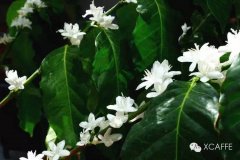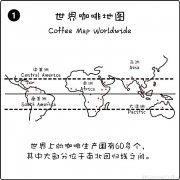Mocha matari is produced in the northern part of Yemen and has a strong sour taste.
Although Yemen is located in the Middle East with the Arabian Peninsula, it can actually be said to be almost closely connected with the African continent opposite the Red Sea. The process of Ethiopian coffee passing through Yemen also illustrates this geographical adjacency. Ethiopian coffee processed in a natural way is still called mocha. With regard to the export of coffee, the quality of coffee has been adversely affected due to the complexity of the circulation process.
Mokamatari, Yemen | Yemen Mocha Mattari
Mokamatari is produced in the northern part of Yemen and has a strong sour taste. Generally speaking, mocha coffee is very unique, has a suitable texture and contains chocolate aroma. Due to the unfavorable climatic conditions in Yemen, it is necessary to cultivate coffee seedlings and then transplant them to step-shaped coffee cultivation sites in alpine areas. As you pass through coffee farms in rural Yemen, you can see spectacular coffee-growing areas that seem to be cut into steps. Because there is less annual precipitation, a unique step waterway that can supply water to coffee trees has been made. Due to this adverse climatic conditions, the general Yemeni coffee raw beans are relatively small in size and very hard in shape. About 35% of Yemeni coffee production is Mokasanani and Mokamatari, which are considered to be of the best quality in Yemeni coffee.
Flavor characteristics: Aroma | Flavor | Acidity | Sweetness | Body | Aftertaste Roasting Point: Light | Cinamon | Medium | High | City | Fullcity | French | Italian Variety: Typica, Bourbon Processing Method: Natural Species: Arabica Flavor: sweetness, fruits, spice, Deep, Earthy,Chocolate, wine
Yemen Mokasanani | Yemen Mocha Sanani
The coffee produced in Sanani, the capital of Yemen, is grown in a high temperature and dry climate at an altitude of about 1000m ∼ 1300m. Varieties include iron pickup and bourbon, Yemeni coffee is mostly processed by natural drying, with rich sweetness and sour taste of fine red wine. The Sanani coffee harvested between November and December has a mild and well-balanced taste and aroma and is a premium coffee.
Flavor characteristics: Aroma | Flavor | Acidity | Sweetness | Body | Aftertaste Roasting Point: Light | Cinamon | Medium | High | City | Fullcity | French | Italian Variety: Typica, BourbonProcessing Method: Natural Species: Arabica Flavor: sweetness, fruits,spice, Deep, Earthy, Chocolate, wine
Summary: countries at the entrance to the Red Sea on the southwest coast of the Arabian Peninsula
Capital: Sana'a (Sanaa)
Language: Arabic
Climate: high temperature climate, monsoon climate, temperate climate
Religion: Sunni Islam 53%, Shiite Islam 46.9%
Production area: Mattari, San'ani,Hirazi/Harasi, Haimi, Saihi, Ismaili, Sharasi, Dhamari, Rimy
Production varieties: Typica, Bourbon, Other Indiginous Varieties
Harvest time: October ∼ February
Planting height: 1000m ∼ 3000m
Grade: Nbig A
Processing method: Natural Dry-Process
Features: Deep, Earthy,Complex and Pungent, Rustic sweetness, fruits, spice

Important Notice :
前街咖啡 FrontStreet Coffee has moved to new addredd:
FrontStreet Coffee Address: 315,Donghua East Road,GuangZhou
Tel:020 38364473
- Prev

Nepalese coffee is produced in the Agganzhi region of Golami, Nepal, by 37 villages, 90
Although Nepalese coffee came from Burma around 1940, Arabica for commercial purposes came from southern India. Although Nepal does not belong to the coffee belt with the equator as the center and within the Tropic of Cancer, it can get sufficient water supply because of heavy fog in the morning and sufficient light in the afternoon because of strong sunlight.
- Next

Brazil is the country with the largest coffee production in the world.
Brazil is the largest coffee producer in the world. Because of the vast territory of Brazil, each farm has its own unique fragrance, no doubt, but also with the standard flavor of Brazil. Not only the coffee quality standard in Brazil is very strict, but also the coffee raw bean processing system in Brazil has reached a very high level from the world standard. West Santos No.2 | Brazil Santos No.2 because
Related
- Does Rose Summer choose Blue, Green or Red? Detailed explanation of Rose Summer Coffee plots and Classification in Panamanian Jade Manor
- What is the difference between the origin, producing area, processing plant, cooperative and manor of coffee beans?
- How fine does the espresso powder fit? how to grind the espresso?
- Sca coffee roasting degree color card coffee roasting degree 8 roasting color values what do you mean?
- The practice of lattes: how to make lattes at home
- Introduction to Indonesian Fine Coffee beans-- Java Coffee producing area of Indonesian Arabica Coffee
- How much will the flavor of light and medium roasted rose summer be expressed? What baking level is rose summer suitable for?
- Introduction to the characteristics of washing, sun-drying or wet-planing coffee commonly used in Mantenin, Indonesia
- Price characteristics of Arabica Coffee Bean Starbucks introduction to Manning Coffee Bean Taste producing area Variety Manor
- What is the authentic Yega flavor? What are the flavor characteristics of the really excellent Yejasuffi coffee beans?

